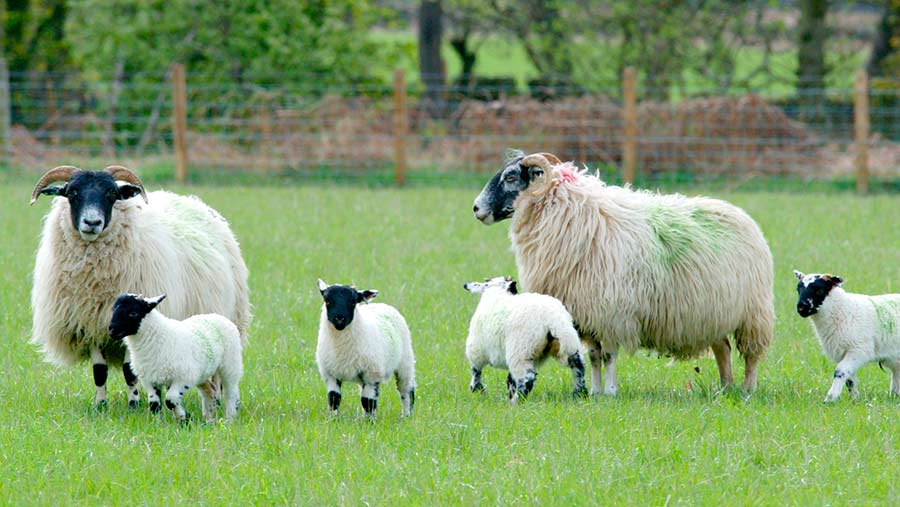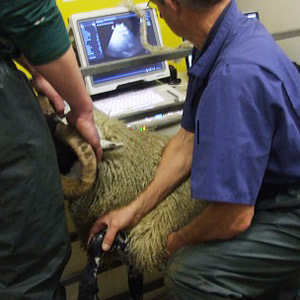Use ultrasound scanning to detect OPA in sheep, farmers told

Ultrasound scanning is currently the best way to manage the infectious and fatal lung disease ovine pulmonary adenocarcinoma (OPA), Scottish farmers are being told.
The technology, which is similar to scanning for lambs, works by locating tumours (2cm or bigger) and is identifying 98% of cases.
See also: OPA test for sheep
By analysing images of lungs at least annually (transthoracic ultrasound scanning), leading vets and researchers say scanning is a “very useful tool” for managing OPA through culling cases as early.
Pressure from farmers has prompted NFU Scotland and Livestock Health Scotland to publish a risk management leaflet detailing lung scanning for diagnostics.
“Lung scanning could be particularly useful when buying stock to rule out introducing OPA into an OPA-free flock and could be adopted as a test and cull policy,” NFU Scotland policy manager Penny Johnston told Farmers Weekly.
“Culling cases earlier will reduce the risk of chronically infected sheep shedding massive quantities of the virus around the flock.”
Vet groups are being encouraged to undertake scanning training, available through the Moredun Research Institute so scanning can become widespread, she added.

A good test
Over the past year, flock screening has shown lung screening to be a “good but not perfect” test for OPA, according to Chris Cousens, who is exploring diagnostic tests for OPA at the Moredun Research Institute.
She admitted scans can yield false positive results, but added that this typically meant culling sheep that were likely to die soon.
“It’s difficult at times to distinguish between abscesses or bacterial lung infections and the OPA tumour,” said Dr Cousens at a recent Moredun Press event.
“However, sheep in this condition never do well and are best sent as culls because, like OPA, if you act fast and cull them in better condition they still have some value, rather than waiting until they are worthless or paying the knackery.”
Severely infected flocks could start annual scanning, which can be fast at a rate of 80 sheep per hour, according to Dr Cousens.
She said annual screening of a batch of cull ewes could also be a way of monitoring OPA.
“We don’t know how much OPA is affecting the sheep industry,” said Dr Cousens. “Some farmers are convinced everyone has it, whereas others are quite unaware of it.”
OPA: A growing problem?
Mule breeder and veterinarian Neil Laing of The Clyde Vet Group has seen OPA in every breed of sheep and believes the virus has recently become a “more pressing” issue for sheep farmers in central and southern Scotland.
During 20 years in practice OPA has evolved from being something that was never seen or discussed to a disease now being confirmed in 5% of clients’ flocks, he told Farmers Weekly.
“OPA or Jaagsiekte appears to be more of an issue,” he warned. “And while abattoir data showing infectivity of 2% in cull ewes suggests its possibly not a big disease at a whole industry level, it could be more of a problem in certain areas.
“Whether it’s going to affect certain breeds more than others like Scrapie did with the Swaledale and Dalesbred in the past is difficult to say.
What we can say is that it is being reported in the mother breeds of Scottish, North of England and Welsh Mules but it’s important to stress that OPA is in all breeds.
“The Blackface Sheep Breeders’ Association is to be commended for giving their members the information they need about the disease and encouraging breeders to seek veterinary advice if they suspect they might have the disease.
“This can involve ultrasound scanning of the lungs – scanning helps to establish the level of infection you have.
“The first ever case I saw was about 15 years ago in a tup. We confirmed it with the wheelbarrow test, which is when you lift up a sheep’s back legs and lower the head to see if mucous and snotty fluid runs out – in this case it did and this was a sign of chronic OPA.
Mr Laing said that, in the absence of a totally accurate and reliable test, the best advice is to start with finding out if you have the disease by postmortem.
If found, and flock masters are worried about getting rid of the disease, annual scanning can identify cases early to be culled, with repeat scans then showing any that were missed at a later date.
“Tumours need to be at least 2cm across the be picked up and are very often golf-ball sized. I would love to have a definitive test; it would put breeders’ minds at ease.”
OPA/Jaagsiekte advice
- Older, thinner sheep may lag behind puffing and panting
- “Pneumonia-type” signs in sheep
- Spread by close contact and through colostrum
- Trough feeding offers potential route of transmission
- Scanning is a useful tool but cannot guarantee absence of OPA
- Wheelbarrow test will pour mucous and snot out of the nose in advanced chronic cases
